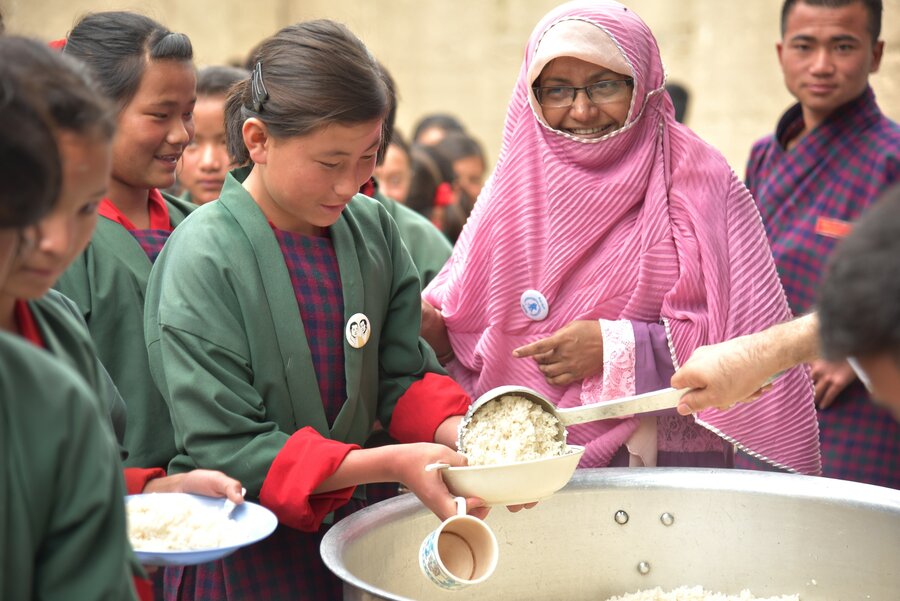Filling bellies, feeding minds: Improving nutrition through school meals
Providing food at school doesn't necessarily mean that kids receive the nutrition they need. Good intentions aside, meals can be missing essential vitamins and minerals needed for good health, or be high in sugar, saturated fats and refined carbohydrates. In short, they may fill stomachs but do little for the nutritional needs of children.

That's why WFP is working to make school meals ‘nutrition-sensitive' — that is, ensuring that menus are designed with nutrition in mind, and provide not just calories but also the nutrients needed by growing bodies and brains.
Here are six ways that the World Food Programme (WFP) and governments around the world are making school meals more nutrition-sensitive.
Increasing diversity on the menu in Kyrgyzstan
Diversity is one of the foundations of a healthy diet. In Kyrgyzstan, WFP is working with the government on the national school meals programme to offer a wider variety of foods. Malnutrition, including micronutrient deficiencies, is an important public health problem in the country, and one of its underlying causes is low dietary diversity.

To increase diversity on the plate, WFP helped work on the menu quality, producing a collection of 146 recipes in collaboration with parents, chefs and school directors, and according to available products and local preferences.
Meal-time transformed from a bun and black tea to a hot balanced meal four times a week. In one school, an analysis of the nutritional value of the meals before and after the project shows an increase in all nutrients measured.
The next steps of the project will include encouraging local suppliers to increase production of a range of foods required for school menus. Providing a stable market can encourage diversification in the foods that local farmers are willing to produce.
Rediscovering ancient foods in Colombia
In order to improve the nutrition of school meals in Colombia's boarding schools, WFP included a native food with a high nutritional value: quinoa. Despite its pre-Hispanic origins, quinoa had all but disappeared from Colombian tables and was in many cases not even known. For this reason, WFP worked to include quinoa in school recipes, sourcing it from a processing company made up of families affected by the armed conflict.

Teaching kids about nutrition in Jordan
In Jordan, WFP's Healthy Kitchen Project is providing a healthy meal to school students along with nutrition education. The programme is already seeing results. "I used to buy chips, biscuits and juice," said one student. "I now tell my mom I want tomatoes, cucumber and bell peppers."

The project is having positive effects on the community by stimulating the local economy through working with suppliers, as well as improving children's performance in school. "Observing the students in my class having the meal on a daily basis, I noticed the improvement in their educational performance," said one teacher in the programme. "This meal helps the students to continue and thrive….The improvement is evident."
Watch the video:
School gardens as a learning tool in El Salvador
In El Salvador, school gardens are being used as a tool both to improve nutrition and as a practical learning tool. A school garden gives canteens a fresh, more secure source of produce to use in recipes. Meanwhile students learn how to grow food in an environmentally friendly way as part of the school curriculum, securing their nutrition for today and tomorrow.


Fortifying rice in Bhutan
After several cases of beri-beri — from deficiency of vitamin B1 (thiamin) — were discovered in school children in Bhutan, the Government requested WFP's support to fortify rice. Fortification — adding vitamins or minerals to commonly eaten foods — is a cost-effective way of fighting micronutrient malnutrition. Now, with technical support from WFP, a local rice mill processes fortified rice for use in Bhutanese schools.
Read Making home-grown school meals in Bhutan.

Connecting schools with local farmers in Honduras
With WFP's support, the government of Honduras is connecting schools with local small-scale producers who provide fresh produce for school menus. Home-grown school meals is WFP's innovative approach that links school meals programmes with local smallholder farmers.
The benefits are many: the schools provide local farmers with a predictable outlet for their products, and the stable income encourages farmers to diversify their production and increase their productivity. Meanwhile children enjoy healthy, diverse meals made with fresh ingredients. In Honduras, the fresh food component includes different types of seasonal fruits and vegetables, eggs, and fish in coastal communities.


Find out more about WFP's work in nutrition and school meals.
Thanks to Geraldine Lecuziat for inputs.
